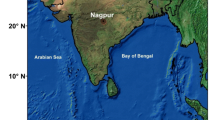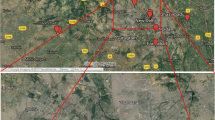Abstract
This study characterizes over 5 years of high time resolution (5 min), airborne black carbon (BC) concentrations (July 2003 to December 2008) measured over Ahmedabad, an urban region in western India. The data were used to obtain different time averages of BC concentrations, and these averages were then used to assess the diurnal, seasonal, and annual variability of BC over the study region. Assessment of diurnal variations revealed a strong association between BC concentrations and vehicular traffic. Peaks in BC concentration were co-incident with the morning (0730 to 0830, LST) and late evening (1930 to 2030, LST) rush hour traffic. Additionally, diurnal variability in BC concentrations during major festivals (Diwali and Dushera during the months of October/November) revealed an increase in BC concentrations due to fireworks displays. Maximum half hourly BC concentrations during the festival days were as high as 79.8 μg m−3. However, the high concentrations rapidly decayed suggesting that local meteorology during the festive season was favorable for aerosol dispersion. A multiple linear regression (MLR) model with BC as the dependent variable and meteorological parameters as independent variables was fitted. The variability in temperature, humidity, wind speed, and wind direction accounted for about 49% of the variability in measured BC concentrations. Conditional probability function (CPF) analysis was used to identify the geographical location of local source regions contributing to the effective BC measured (at 880 nm) at the receptor site. The east north-east (ENE) direction to the receptor was identified as a major source region. National highway (NH8) and two coal-fired thermal power stations (at Gandhinagar and Sabarmati) were located in the identified direction, suggesting that local traffic and power plant emissions were likely contributors to the measured BC.







Similar content being viewed by others
References
ART, Ahmedabad Bus Rapid Transit System, India. ART report 2006, <http://www.ahmedabadbrts.com/images/05.Traffic%20volume%20characteristics%20&%20Juunction%20Management.pdf>, accessed on 22/06/10
Baron R E, Montgomery W D and Tuladhar S D (2010) An analysis of black carbon mitigation as a response to climate change, Copenhagen Consensus Center, <http://fixtheclimate.com/uploads/tx_templavoila/AP_Black_Carbon_Baron_Montgomery_Tuladhar_v.4.0.pdf>, accessed on 20/06/10
Bodhaine BA (1995) Aerosol absorption measurements at Barrow, Mauna Loa and the South Pole. J Geophys Res 100:8967–8975
CPCB, Central Pollution Control Board, India. CBCB Air quality data 2004–2006, downloaded via <http://www.cpcb.nic.in/Air_quality_data.php>, accessed on 27/07/10
Fochesatto J, Drobinski P, Flamant C, Guedalia D, Sarrat C, Flamant P, Pelon J (2001) Evidence of dynamical coupling between the residual layer and the developing convective boundary layer. Bound-Layer Meteorol 99:451–464
NASA GES–DISC, NASA Goddard Earth Sciences Data and Information Services Center, USA. Precipitation data 2003–2008 downloaded via <http://disc.sci.gsfc.nasa.gov/giovanni>, accessed on 15/06/2010
Han YJ, Holsen TM, Hopke PK, Yi SM (2005) Comparison between back trajectory based modeling and Lagrangian backward dispersion modeling for locating sources of reactive gaseous mercury. Environ Sci Technol 39:1715–1723
Hansen ADA (2005) The Aethalometer, Magee Scientific 2005, <http://mageesci.com/support/downloads/Aethalometer_book_2005.07.03.pdf>, accessed on 23/07/2010
Hansen ADA, Rosen H, Novakov T (1984) The aethalometer—an instrument for the real-time measurement of optical absorption by aerosol particles. Sci Total Environ 36:191–196
Jarvi L, Junninen H, Karppinen A, Hillamo R, Virkkula A, Makela T, Pakkanen T, Kulmala M (2007) Black carbon concentration trends in Helsinki during 1996–2005. Atmos Chem Phys Discuss 7:14265–14294
Kim E, Hopke PK (2004) Source apportionment of fine particles at Washington, DC utilizing temperature resolved carbon fractions. J Air Waste Manag Assoc 54:773–785
Kim E, Hopke PK, Larson TV, Maykut NN, Lewtas J (2004) Factor analysis of Seattle fine particles. Aerosol Sci Technol 38:724–738
Latha KM, Badarinath KVS (2005) Seasonal variations of black carbon aerosols and total aerosol mass concentrations over urban environment in India. Atmos Environ 39:4129–4141
Menon S, Koch D, Beig G, Sahu S, Fasullo J, Orlikowski D (2010) Black carbon aerosols and the third polar ice cap. Atmos Chem Phys 10:4559–4571
Nishanth T, Satheesh Kumar MK (2011) Increasing trends of tropospheric ozone and NO2 at the prominent hot spots along the coastal belt of the Arabian Sea in Indian Subcontinent. Int J Environ Sci 1 No.5
Nishanth T, Praseed KM, Rathnakaran K, Satheesh Kumar MK, Ravi Krishna R, Valsaraj KT (2012) Atmospheric pollution in a semi-urban, coastal region in India following festival seasons. Atmos Environ 47:295–306
Ramachandran S, Rajesh TA (2007) Black carbon aerosol mass concentrations over Ahmedabad, an urban location in western India: comparison with urban sites in Asia, Europe, Canada, and the United States. J Geophys Res 112:D06211
Reddy MS, Venkataraman C (2002) Inventory of aerosol and sulphur dioxide emissions from India: I—fossil fuel combustion. Atmos Env 36:677–697
Sunder Raman R, Ramachandran S, Rastogi N (2010) Source identification of ambient aerosols over an urban region in western India. J Environ Monit 12:1330–1340
USAID, United States Agency for International Development (2010) Black carbon emission in Asia: sources, impacts, and abatement opportunities, <http://usaid.eco-asia.org/programs/cdcp/reports/summary-black-carbon-emissions-in-asia.pdf>, accessed on 27/07/10.
Venkatachari P, Zhou L, Hopke PK, Felton D, Rattigan OV, Schwab JJ, Demerjian KL (2006) Spatial and temporal variability of black carbon in New York City. J Geophys Res 111(10):D10S05
Watson JG, Chow JC (2001) Source characterization of major emission sources in the Imperial and Mexicali Valleys along the US/Mexico border. Sci Tot Environ 276:33–47
Author information
Authors and Affiliations
Corresponding author
Additional information
Responsible editor: Philippe Garrigues
Electronic supplementary material
Below is the link to the electronic supplementary material.
ESM 1
(DOC 2318 kb)
Rights and permissions
About this article
Cite this article
Bapna, M., Sunder Raman, R., Ramachandran, S. et al. Airborne black carbon concentrations over an urban region in western India—temporal variability, effects of meteorology, and source regions. Environ Sci Pollut Res 20, 1617–1631 (2013). https://doi.org/10.1007/s11356-012-1053-3
Received:
Accepted:
Published:
Issue Date:
DOI: https://doi.org/10.1007/s11356-012-1053-3




